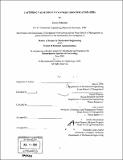Capturing value from Item Unique Identification (IUID)
Author(s)
Salamini, Alexey
DownloadFull printable version (11.15Mb)
Alternative title
Capturing value from IUID
Other Contributors
Leaders for Manufacturing Program.
Advisor
Daniel Whitney and Roy Welsch.
Terms of use
Metadata
Show full item recordAbstract
The Department of Defense has issued a mandate aimed at improving its capabilities in determining the location, value, quantity, and condition of government assets. The mandate requires marking specified assemblies and components with a unique identifier using two-dimensional data matrix technology. Item Unique Identification (IUID), comprised of data matrix technology and the Unique Item Identifier (UII) data construct, was chosen to create a global standard for identification and because it showed promise in providing lifetime tracking of assets. Currently, Raytheon's implementation strategy to address the mandate has focused solely on compliance and does not aim to extract value from the IUID mandate or the UII construct. However there are many potential benefits of these capabilities. This thesis attempts to identify potential usage scenarios, determine if they are a worthwhile investment, and develop a more deliberate IUID strategy for Raytheon as a corporation within the context of the existing tracking and information landscape. It was determined that company wide pre-tax net savings of $10.6 ( 5.4) Million annually are possible from leveraging IUID technology in repair operations alone. (cont.) This study recommends a pilot program and if successful, to continue to leverage IUID in those repair programs with: more than 500 units processed annually, more than five workstations, and an IUID requirement in place. This study also recommends that Raytheon should not mark above contractual requirements but should encourage customers to implement IUID marking for high volume programs. This study led to additional recommendations for operations strategy at Raytheon. Automated rather than manual (keystrokes) data entry should be promoted in all operations; specifically in high volume applications. Raytheon should also make a practice of purchasing scanners that detect both bar codes and data matrices for all operations. Finally, the UII construct should be adopted in company wide operations independent of which technology (bar code, 2D Matrix, or Radio Frequency Identification (RFID)) is used to read or deliver it.
Description
Thesis (S.M.)--Massachusetts Institute of Technology, Dept. of Mechanical Engineering; and, (M.B.A.)--Massachusetts Institute of Technology, Sloan School of Management; in conjunction with the Leaders for Manufacturing Program at MIT, 2006. Includes bibliographical references (leaves 90-91).
Date issued
2006Department
Leaders for Manufacturing Program at MIT; Massachusetts Institute of Technology. Department of Mechanical Engineering; Sloan School of ManagementPublisher
Massachusetts Institute of Technology
Keywords
Mechanical Engineering., Sloan School of Management., Leaders for Manufacturing Program.